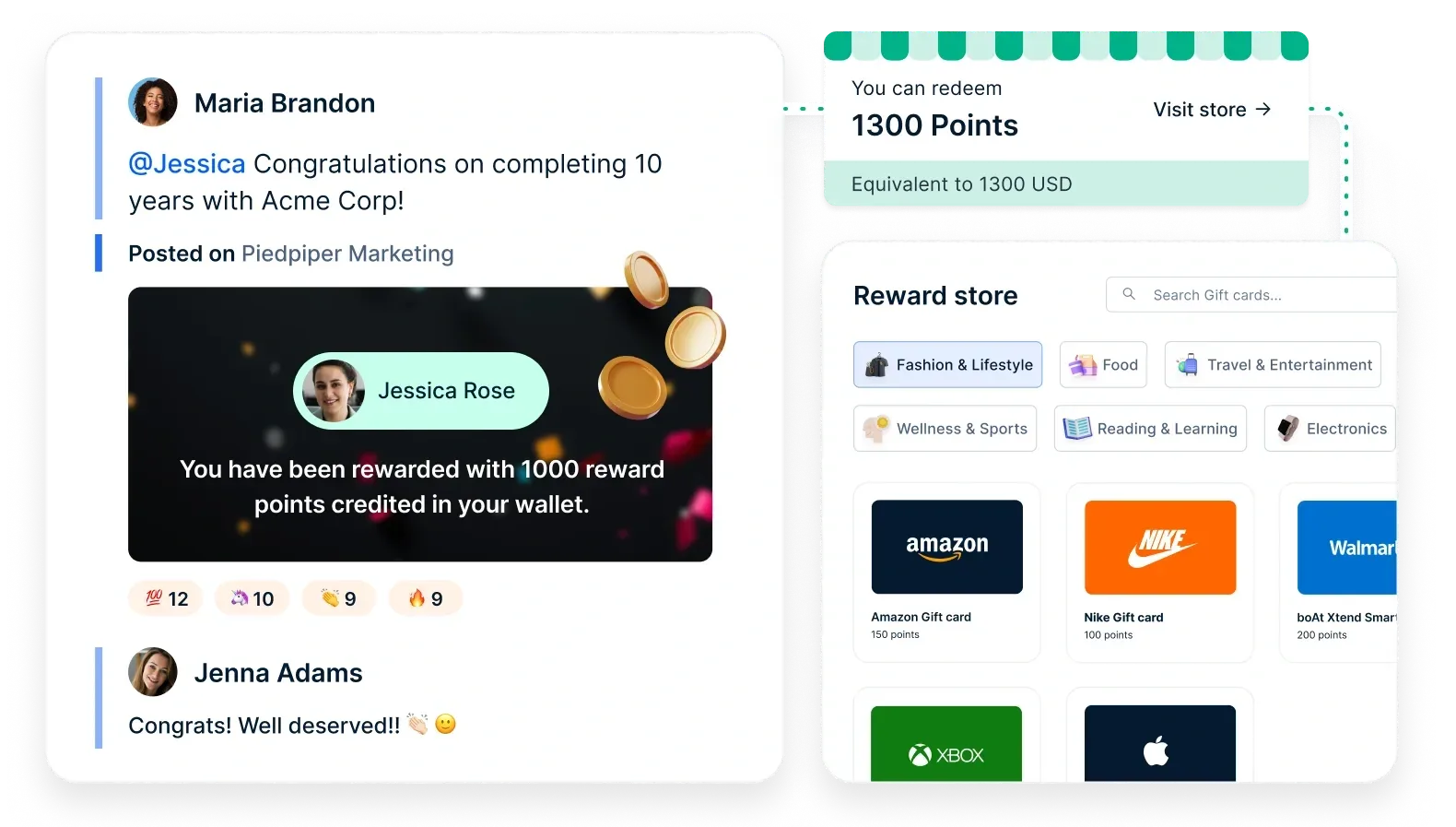55+ Las mejores recompensas por rendimiento para motivar y retener a los empleados
Looking for the best ways to recognize employees? Explore 17 proven performance rewards that drive motivation, increase retention, and foster a high-performing work culture.
En esta página
- Comprender las necesidades y preferencias de sus empleados
- Cómo recompensar a los empleados por su buen rendimiento: 17 formas eficaces
- 7 formas digitales de recompensar a un empleado por su buen rendimiento con tarjetas regalo
- 32 More ideas to reward employees for good performance
- How to start a performance recognition program?
- Buenas prácticas para los programas de reconocimiento del rendimiento
- Conclusión
- Preguntas frecuentes
Do you actively recognize and reward your employees for their dedication and achievements? While many businesses acknowledge the value of employee appreciation, implementing an effective performance rewards system can be challenging.
True recognition goes beyond occasional praise or annual bonuses—it requires a well-planned strategy that aligns performance rewards with individual motivation and company objectives.
By fostering a culture of appreciation, businesses can boost productivity, enhance workplace morale, and drive long-term success.
Effective rewards recognize and celebrate achievements, boost employee morale, and motivate them to strive for excellence. But with so many options available, how do you choose the right performance rewards? We have compiled a list of 55+ ideas or ways to reward employees for their performance.
Comprender las necesidades y preferencias de sus empleados
Antes de hablar de recompensas específicas, es esencial comprender qué motiva a sus empleados. No a todo el mundo le motivan las mismas cosas. Algunos valoran los incentivos económicos, como las primas o los aumentos de sueldo, mientras que otros prefieren las oportunidades de desarrollo profesional o la flexibilidad laboral.
He aquí algunas estrategias para tomar el pulso a las preferencias de sus empleados:
- Encuestas: Realice encuestas anónimas para recabar opiniones sobre los tipos de recompensa preferidos.
- Grupos de discusión: Organice grupos de discusión para debatir en profundidad qué motiva a los empleados y cuáles son sus programas de reconocimiento ideales.
- Política de puertas abiertas: Fomente una cultura de comunicación abierta en la que los empleados se sientan cómodos compartiendo sus ideas y aspiraciones.
Al comprender lo que realmente motiva a su plantilla, puede adaptar su programa de recompensas para ofrecer una combinación de recompensas intrínsecas y extrínsecas que satisfagan las distintas necesidades.
Cómo recompensar a los empleados por su buen rendimiento: 17 formas eficaces
Recognizing and rewarding employees for their hard work and outstanding performance is a crucial aspect of maintaining a motivated and engaged workforce. Effective rewards not only boost morale but also contribute to higher job satisfaction and increased productivity.
Here are the effective performance rewards ideas for good performance.
1. Bonificaciones por rendimiento
Las primas por rendimiento son una forma habitual y eficaz de recompensar a los empleados por su excelente trabajo. Suelen estar vinculadas a métricas de rendimiento o logros específicos, como el cumplimiento de los objetivos de ventas, la superación de los objetivos de un proyecto o la superación de los puntos de referencia de satisfacción del cliente.
Performance rewards or bonuses provide employees with a direct financial incentive for their exceptional efforts and contributions. To maximize their impact, it's important to set clear and achievable performance targets, communicate the criteria for earning bonuses transparently, and ensure timely and fair distribution of rewards.
Muchas empresas ofrecen bonificaciones basadas en el rendimiento como forma de recompensar a los empleados por alcanzar objetivos específicos o superar las expectativas de rendimiento. Estas primas pueden ser pagos únicos o formar parte de un programa de incentivos estructurado.
2. Participación en los beneficios
Los programas de participación en los beneficios están diseñados para distribuir una parte de los beneficios de una empresa entre sus empleados. Este enfoque alinea los intereses de los empleados con el éxito financiero de la organización.
La participación en los beneficios puede estructurarse de varias maneras, como asignando un porcentaje de los beneficios a los empleados que reúnan los requisitos o utilizando una fórmula predeterminada. Al participar en el éxito financiero de la empresa, los empleados se sienten más identificados y motivados para contribuir al crecimiento y la rentabilidad de la organización.
Algunas empresas reparten una parte de sus beneficios entre los empleados como forma de recompensarles por su contribución al éxito de la empresa. Esto puede distribuirse mediante primas, planes de participación en beneficios u opciones sobre acciones.
3. Reconocimientos y premios
Recognizing and rewarding employees through various forms of recognition and awards can have a significant positive impact on morale and motivation. This can include verbal praise, certificates, plaques, or other tangible tokens of appreciation.
Personalizar estos reconocimientos en función de las preferencias y los logros individuales los hace aún más significativos. Celebrar públicamente los logros de los empleados durante las reuniones de equipo o los eventos de toda la empresa también puede aumentar su sentimiento de orgullo y compromiso.
El reconocimiento constante refuerza la cultura de la excelencia y anima a los empleados a seguir ofreciendo un rendimiento excepcional.
Empuls simplifies employee recognition and rewards by providing a digital platform to acknowledge and celebrate achievements seamlessly. It enables organizations to offer personalized recognition, including peer-to-peer appreciation, awards, and incentives that align with company values.
With customizable rewards, real-time recognition, and automated milestone celebrations, Empuls fosters a culture of appreciation that boosts morale, motivation, and engagement. Public recognition through company-wide feeds and team announcements further enhances employees' sense of pride and belonging.
For example: Marriott International has a "Spirit to Serve Our Communities" program that recognizes employees who go above and beyond in their community service efforts. They receive awards and recognition for their contributions.
4. Oportunidades de desarrollo profesional
Invertir en el crecimiento profesional de los empleados es una forma valiosa de recompensar su buen rendimiento. Ofrecer oportunidades de desarrollo de habilidades, asistir a programas de formación, talleres o conferencias y apoyar la formación continua puede mejorar sus conocimientos y capacidades.
Esto no sólo beneficia a los empleados personal y profesionalmente, sino que también demuestra el compromiso de la organización con su éxito a largo plazo. Personalizar los planes de desarrollo profesional para alinearlos con los objetivos profesionales individuales y las necesidades de la empresa puede hacer que este tipo de recompensa sea especialmente impactante.
5. Beneficios de la conciliación de la vida laboral y familiar
In today's fast-paced work environment, employees often struggle to maintain a healthy work-life balance. Providing work-life balance benefits is a valuable way to reward employees for their dedication.
Estos beneficios pueden incluir horarios de trabajo flexibles, opciones de trabajo a distancia o tiempo libre remunerado adicional. Al permitir a los empleados gestionar mejor su vida personal y profesional, les demuestra que su bienestar es importante, lo que puede aumentar su lealtad y compromiso.
6. Programas de bienestar
Investing in the physical and mental well-being of your employees is a win-win strategy. Implementing wellness programs such as gym memberships, on-site yoga classes, or access to counseling services can help reduce stress and improve overall health.
Reconocer a los trabajadores de alto rendimiento con este tipo de iniciativas de bienestar no sólo mejora su calidad de vida, sino que también demuestra su compromiso con su bienestar integral.
Empuls supports employee mental wellness by fostering relaxation, focus, and creativity. Organizations can create contests and rewards for activities like daily journaling, morning meditation, or regular breaks, encouraging mindfulness. By integrating wellness-focused initiatives, Empuls helps employees manage stress and boost productivity, contributing to a healthier and more engaged workforce.
7. Empleado del mes/trimestre/año
Traditional recognition programs like "Employee of the month" are still effective at acknowledging outstanding performance. These programs allow you to publicly celebrate an employee's achievements, often accompanied by a plaque, certificate, or a designated parking spot.
Este reconocimiento no sólo eleva la moral del galardonado, sino que también inspira a los demás a luchar por la excelencia, creando una cultura de sana competencia.
8. Reconocimiento entre iguales
While formal recognition is essential, peer recognition can be equally powerful. Encourage employees to acknowledge and appreciate each other's contributions. You can implement a peer-to-peer recognition system, where employees can nominate their colleagues for outstanding work. This fosters a sense of camaraderie and teamwork while reinforcing positive behaviors.
9. Recompensas y ventajas personalizadas
Not all employees have the same preferences when it comes to rewards. To make your recognition efforts more impactful, consider offering personalized rewards and perks. Get to know your employees' interests, hobbies, or career goals, and tailor rewards accordingly.
This could range from tickets to a sporting event for a sports enthusiast, additional professional development opportunities for a career-focused individual, giving out learning rewards, or a spa day for someone who values relaxation.
10. Paquetes de prestaciones flexibles
Employee benefits are a valuable form of recognition. Instead of offering a standard benefits package, consider providing flexible benefits options that allow employees to choose the perks that matter most to them.
Esto podría incluir opciones como horarios de trabajo flexibles, acuerdos de trabajo a distancia, opciones adicionales de atención sanitaria o la posibilidad de asignar una parte de su retribución a las prestaciones de su elección. Un paquete de beneficios flexible permite a los empleados adaptar sus retribuciones a sus necesidades y prioridades específicas.
11. Tiempo de innovación
Asigne tiempo a los empleados para que trabajen en proyectos innovadores de su elección. Puede ser un porcentaje fijo de su semana laboral o un número determinado de días al mes. Esta autonomía permite a los empleados explorar su creatividad y contribuir potencialmente al crecimiento de la empresa con nuevas ideas y soluciones.
12. Promociones y ascensos
Una de las formas más significativas de reconocimiento y recompensa es la oportunidad de progresar profesionalmente. Los ascensos y promociones no solo conllevan mayores responsabilidades, sino también una mayor remuneración y el reconocimiento de las capacidades y el potencial de un empleado.
Cuando los empleados ven una vía clara de crecimiento dentro de la organización, es más probable que sigan comprometidos y motivados para rendir al máximo. Asegúrese de que las decisiones de ascenso son transparentes y se basan en los méritos para mantener un entorno de trabajo justo y motivador.
13. Proyectos especiales y funciones de liderazgo
Reconozca a los empleados excepcionales implicándoles en proyectos especiales o asignándoles funciones de liderazgo dentro de la organización. Estas oportunidades no sólo suponen un nuevo reto, sino que también sirven como clara demostración de confianza en sus capacidades.
Ya se trate de dirigir un proyecto de gran impacto, tutelar a los miembros más jóvenes del equipo o representar a la empresa en una iniciativa clave, estas funciones pueden ser inmensamente gratificantes y motivadoras para los empleados de alto rendimiento.
14. Experiencias de viaje de los empleados
Offer employees the opportunity to embark on exciting travel experiences as a reward. This can include fully paid vacations, weekend getaways, or travel vouchers. With efficient travel booking software, employees can seamlessly plan and book their trips, ensuring a hassle-free experience from start to finish.
Travel not only serves as a refreshing break but also allows employees to create lasting memories. It can be a powerful motivator and a way to thank employees for their dedication.
Travel not only serves as a refreshing break but also allows employees to create lasting memories. It can be a powerful motivator and a way to thank employees for their dedication.
15. Sabáticos
Un año sabático es un periodo prolongado de excedencia con continuidad en el empleo, que suele concederse tras varios años de servicio. Los periodos sabáticos brindan a los empleados la oportunidad de dedicarse a sus intereses personales, ampliar su formación o simplemente reponer fuerzas.
This extended break can be a unique and highly valued reward for long-term employees who have consistently demonstrated exceptional performance.
16. Tiempo libre por servicio comunitario
Anime a los empleados a retribuir a sus comunidades ofreciéndoles tiempo libre retribuido para hacer voluntariado o participar en actividades benéficas. Esto no sólo beneficia a los empleados personalmente, sino que también refleja positivamente los esfuerzos de responsabilidad social corporativa de su empresa. Demuestra que usted valora su compromiso para marcar la diferencia en el mundo.
17. Igualación de donaciones
Incentive a los empleados para que contribuyan a las causas que les importan poniendo en marcha un programa de igualación de donativos. Cuando los empleados hacen donaciones benéficas, la empresa iguala un porcentaje o el importe total. Esto no sólo apoya causas importantes, sino que también refuerza el compromiso de la empresa con la responsabilidad social y el compromiso de los empleados.

Mantenga a sus empleados motivados y comprometidos
Un sueldo no es suficiente: los empleados necesitan reconocimiento, recompensas significativas y un sentimiento de pertenencia. Con Empuls, celebra los logros y aumenta la motivación sin esfuerzo.
7 formas digitales de recompensar a un empleado por su buen rendimiento con tarjetas regalo
He aquí 7 formas digitales de recompensar a los empleados por su buen rendimiento con tarjetas regalo.
1. Experiencias gastronómicas
Gift cards for dining experiences are a delightful way to reward employees. These cards can be for popular local restaurants, national chain eateries, or food delivery services like UberEATS or doordash. Employees can use them to enjoy a meal out with friends or family or have their favorite dishes delivered to their doorstep.
You might provide employees with gift cards to well-regarded restaurants in your city, ensuring a diverse range of culinary options to suit different tastes.
2. Terapia al por menor
Las tarjetas regalo para terapia de compras permiten a los empleados darse el capricho de ir de compras, ya sea de ropa, electrónica, artículos para el hogar o artículos personales. Estas tarjetas regalo pueden ser para tiendas populares, tanto físicas como online.
For example, you could provide gift cards for well-known retailers such as Amazon, target, or a favorite clothing brand, offering a wide array of shopping options.
3. Entretenimiento y ocio
Entertainment and leisure gift cards cover a broad spectrum of rewards, including movie theater gift cards, subscriptions to streaming services like Netflix or Disney+, passes to amusement parks, or tickets to concerts and sporting events.
Por ejemplo, puede ofrecer tarjetas regalo para cines o parques temáticos populares, que permitan a los empleados divertirse y crear recuerdos duraderos con amigos y familiares.
4. Viajes y aventura
Travel and adventure gift cards open the door to exciting experiences. They can include airline gift cards, hotel chain vouchers, or gift cards for corporate travel booking sites, allowing employees to plan a getaway, vacation, or adventure trip.
For example, you might provide gift cards for well-known airlines like delta or American airlines, or for hotel chains like Marriott or Hilton, giving employees the flexibility to plan their dream trip.
5. 5. Servicios de suscripción
Subscription service gift cards provide access to various online services. These can include streaming platforms like Netflix, music streaming like Spotify, or wellness apps for fitness and meditation.
For example, you could offer gift cards for popular subscription services like Netflix, Spotify, headspace (a meditation app), or a fitness platform like peloton, allowing employees to choose what aligns with their interests and lifestyle.
6. Tarjetas regalo de alimentos y bebidas gourmet
Las tarjetas regalo para experiencias gastronómicas pueden incluir vales para cafeterías especializadas, teterías de alta gama, panaderías artesanales o mercados de alimentos gourmet. Los empleados pueden utilizar estas tarjetas para saborear alimentos y bebidas de primera calidad.
Por ejemplo, puede ofrecer tarjetas regalo a una prestigiosa tostadora de café local o a una panadería gourmet conocida por sus exquisitos pasteles y golosinas, lo que permitirá a los empleados degustar sabores excepcionales.
7. Tarjetas regalo de la librería
Provide employees with gift cards to well-known bookstores, both physical and online, such as Barnes & Noble or amazon. This allows employees to explore and purchase books of their choice, whether for leisure, personal development, or professional growth.
For example, you could offer employees gift cards to a local independent bookstore or a major online retailer like amazon, ensuring access to a wide variety of reading materials.
Case Study: How Fresh works Inc, used Plum to automate and distribute $5000+ worth digital gifts within a few clicks.
Fresh works Inc., a prominent NASDAQ-listed SaaS company, partnered with Plum to streamline the distribution of digital gifts worth over $5,000. The challenges Freshworks faced included the need to gift event participants in various global locations, complexities in incentivizing Account Based Marketing (ABM) and referral campaigns, sourcing local vendors, dealing with currency conversion issues, and lacking a personalized approach.
To overcome these challenges, Freshworks implemented Plum's rewards platform and leveraged Zapier integration to create custom workflows for rewarding customers seamlessly. They utilized "Xoxo Codes" and "Xoxo Links" to:
1. Run customized referral campaigns, automating the distribution of localized rewards to referrers worldwide.
2. Incentivize ABM campaigns by offering personalized virtual meetings and increasing brand awareness.
3. Enhance event participation by sending digital gifts to speakers and participants across different regions.
Freshworks benefited from Plum's extensive reward catalog, which includes options from over 21,000 choices across 75+ countries. They distributed $5,000+ in brand vouchers with just a few clicks, thanks to Plum's user-friendly platform and Zapier integration. Xoxoday's tech support also helped create custom landing pages and simplified currency conversions for end-users.
Looking ahead, Freshworks plans to use Empuls for virtual lunches and incentivizing internal teams for driving event registrations, further leveraging the platform's flexibility and robustness.
Sandeep John from Freshworks praised Plum's experience, highlighting the platform's ability to address their gifting challenges effectively.
32 More ideas to reward employees for good performance
Here are 10 ideas for performance rewards:
1. Modalidades de trabajo flexibles
Ofrezca a los empleados flexibilidad para elegir su horario de trabajo, trabajar a distancia o tener semanas laborales comprimidas. Esto les permite conciliar mejor el trabajo y la vida personal.
2. Iniciativas de salud y bienestar
Implemente programas que fomenten el bienestar de los empleados, como clases de gimnasia, sesiones de meditación o acceso a recursos de salud mental.
3. Notas de agradecimiento personalizadas
Escriba notas de agradecimiento personalizadas en las que exprese su reconocimiento por las contribuciones específicas de un empleado, destacando sus logros individuales.
4. Oficinas diseñadas por los empleados
Permita que los empleados opinen sobre el diseño y la decoración de su espacio de trabajo, creando un entorno más personalizado y confortable.
5. Prestaciones familiares
Las prestaciones favorables a la familia ofrecen beneficios que apoyan a los empleados con familia, como guarderías in situ, políticas flexibles de baja parental o ayudas para gastos relacionados con la escuela.
6. Planes de adquisición de acciones por los empleados (ESOP)
Ofrezca a los empleados la oportunidad de convertirse en propietarios parciales de la empresa mediante la titularidad de acciones, alineando sus intereses con el éxito de la empresa.
7. Celebraciones laborales sorpresa
Organice celebraciones o eventos inesperados en el trabajo para reconocer logros o hitos, creando un ambiente divertido y festivo.
8. Acceso a eventos exclusivos
Ofrezca a los empleados entradas o acceso a eventos, conciertos o espectáculos exclusivos como recompensa por su excepcional rendimiento.
9. Reconocimiento de los empleados en las publicaciones de la empresa
Destaque a los empleados destacados en boletines, revistas o redes sociales de la empresa para reconocer públicamente sus contribuciones y aumentar su visibilidad dentro de la organización.
10. Oportunidades para establecer contactos profesionales
Ofrezca a los empleados de alto rendimiento la oportunidad de asistir a conferencias, seminarios o eventos de networking del sector. Esto no solo les recompensa, sino que también les ayuda a ampliar su red profesional y mantenerse al día de las tendencias del sector.
11. Programa de intercambio de competencias
Anime a los empleados a compartir sus habilidades y conocimientos únicos con sus compañeros a través de un programa de "Intercambio de habilidades". Puede ser una plataforma para que los empleados impartan talleres o dirijan sesiones de formación, fomentando una cultura de aprendizaje continuo y colaboración.
12. Actos de agradecimiento a los empleados
Organice eventos exclusivos como proyecciones privadas de películas, fiestas temáticas o experiencias gastronómicas únicas para los empleados de alto rendimiento y sus familias, creando momentos memorables de reconocimiento y celebración.
13. Darles notas escritas a mano
Adopte un enfoque personal escribiendo notas a mano en las que exprese su agradecimiento por el duro trabajo y las contribuciones de sus empleados. Un mensaje sincero puede tener un profundo impacto y hacer que los empleados se sientan valorados y reconocidos.
14. Permitirles salir antes
Sorprenda a los empleados de alto rendimiento permitiéndoles salir del trabajo unas horas antes. Es una forma sencilla pero eficaz de proporcionarles algo más de tiempo libre para que se relajen y disfruten de su vida personal.
15. Proporcionarles una afiliación a un club de salud
Fomente un estilo de vida saludable ofreciendo a sus empleados una suscripción a un gimnasio o a clases de fitness. Esto no solo fomenta el bienestar físico, sino que también demuestra que te preocupas por su salud y su conciliación de la vida laboral y personal.
16. Llevarles el desayuno
Organice un desayuno sorpresa para el equipo o el triunfador individual. Un delicioso desayuno puede levantar la moral y dar un tono positivo a la jornada, fomentando la camaradería y el aprecio.
17. Permítales trabajar desde casa durante un día
Conceda a los empleados de alto rendimiento la flexibilidad de trabajar desde casa durante un día. Esto les proporciona un cambio de aires y les permite trabajar en un entorno cómodo y personalizado.
18. Ver una película en la oficina
Organiza una sesión de cine en la oficina a la hora de comer o después del trabajo. Deje que los empleados voten la película, ofrezca palomitas y aperitivos y cree un ambiente relajado para que se relajen y disfruten.
19. Proporcionarles entradas para eventos o festivales
Ofrezca entradas para conciertos, acontecimientos deportivos o festivales culturales que coincidan con los intereses de sus empleados. Así podrán disfrutar de experiencias memorables y crear recuerdos duraderos.
20. Cambiar el código de vestimenta periódicamente
Introduce "Casual Fridays" or themed dress-up days to add a fun and relaxed element to the workplace. This change in the dress code can make the work environment more enjoyable.
21. Colocar sus logros en algún lugar público
Celebra los logros de los empleados publicándolos en un tablón de anuncios específico, en el boletín de la empresa o en las redes sociales. El reconocimiento público puede aumentar su confianza y motivación.
22. Regalarles regalos de empresa
Proporcione a los empleados artículos con la marca de la empresa, como camisetas, botellas de agua o accesorios de escritorio personalizados. Esto no sólo fomenta el orgullo de la empresa, sino que también sirve como recordatorio tangible de sus logros.
23. Clases de idiomas
Ofrezca clases de idiomas para ayudar a los empleados a mejorar sus habilidades comunicativas. Estas clases pueden adaptarse a los idiomas más relevantes para sus funciones laborales o intereses personales. Aprender un nuevo idioma puede mejorar la capacidad de los empleados para colaborar con colegas internacionales, atender a clientes de diversos orígenes o, simplemente, enriquecer sus experiencias culturales.
24. Días de celebración cultural
Organice actos para celebrar diversas fiestas y tradiciones culturales. Esto fomenta un sentimiento de inclusión y diversidad en el lugar de trabajo. Los empleados de distintos orígenes culturales pueden compartir sus tradiciones, comidas y costumbres, fomentando un entorno de trabajo más integrador y armonioso.
25. Sesiones de fotos profesionales
Organice sesiones fotográficas profesionales para los empleados y sus familias. Esta recompensa permite a los empleados crear recuerdos duraderos y retratos familiares de alta calidad. Puede ser especialmente apreciada para capturar hitos, como aniversarios o acontecimientos importantes de la vida.
26. Club de lectura o círculos de aprendizaje
Cree un club de lectura de empresa o círculos de aprendizaje en torno a temas específicos. Esto fomenta el aprendizaje y el debate continuos entre los empleados. Leer y comentar libros o materiales didácticos relacionados con su campo o su desarrollo personal puede dar lugar a valiosas reflexiones y conocimientos compartidos.
27. Gadgets tecnológicos
Ofrezca los últimos gadgets o accesorios tecnológicos como recompensa. Esto incluye artículos como teléfonos inteligentes, tabletas, auriculares con cancelación de ruido u otras tecnologías de vanguardia. Estas recompensas pueden atraer a los empleados más tecnológicos y mejorar su eficiencia laboral y su disfrute personal.
28. Celebración de hitos
Reconozca los aniversarios laborales con celebraciones y premios especiales. Las celebraciones de hitos pueden incluir regalos personalizados, certificados o eventos dedicados para honrar la lealtad y el compromiso de los empleados con la organización. Estas celebraciones crean una cultura positiva en el lugar de trabajo y refuerzan las relaciones a largo plazo.
29. 29. Asesoramiento financiero
Ofrezca servicios de planificación y asesoramiento financiero para ayudar a los empleados a gestionar sus finanzas. Los programas de bienestar financiero pueden proporcionar valiosos consejos sobre presupuestos, inversiones, gestión de deudas y planificación de la jubilación, contribuyendo al bienestar general de los empleados y reduciendo el estrés financiero.
30. Salas de meditación
Designe espacios tranquilos para la meditación y la relajación. Las salas de meditación ofrecen a los empleados un santuario para desestresarse, relajarse y volver a concentrarse durante la jornada laboral. Estos espacios favorecen la salud mental y la productividad, al tiempo que demuestran el compromiso de la empresa con el bienestar de los empleados.
31. Retos sanitarios
Organice retos de bienestar con recompensas por alcanzar objetivos de salud. Estos retos pueden animar a los empleados a adoptar estilos de vida más saludables a través de actividades como retos de pasos, competiciones de pérdida de peso o programas de atención plena. Las recompensas pueden incluir monitores de fitness, vales de bienestar o tiempo libre adicional.
32. Proyectos paralelos de los empleados
Apoye y financie los proyectos paralelos o las iniciativas empresariales de los empleados. Esta recompensa única permite a los empleados perseguir sus pasiones e intereses fuera de su trabajo habitual. Al respaldar sus proyectos paralelos, la empresa muestra su aprecio por la creatividad y el espíritu emprendedor de los empleados, lo que puede dar lugar a ideas innovadoras y oportunidades de negocio.
While these performance rewards ideas are good, the best way to ensure that everyone is rewarded methodically and religiously is implementing the performance recognition program.
Los programas de reconocimiento del rendimiento son iniciativas estructuradas diseñadas para reconocer y recompensar a los empleados por sus logros y contribuciones. Estos programas pretenden crear una cultura de reconocimiento celebrando sistemáticamente los éxitos individuales y de equipo.
Los elementos clave de los programas de reconocimiento de éxito incluyen criterios claros para el reconocimiento, agradecimiento oportuno, recompensas personalizadas y un equilibrio entre el reconocimiento individual y el de grupo. Al incorporar estos componentes, las empresas pueden garantizar que sus esfuerzos de reconocimiento tengan impacto y estén alineados con los objetivos de la organización.
How to start a performance recognition program?
A partir de estos ejemplos, la implantación de un programa de reconocimiento del rendimiento con éxito implica varios pasos clave:
- Define your recognition objectives: Identify what behaviors, achievements, or milestones you want to recognize and align these objectives with your company’s values and goals.
- Choose recognition methods that align with company culture: Select recognition methods that resonate with your employees, whether through formal awards, peer-to-peer recognition, or personalized rewards.
- Roll out the program and communicate it effectively: Ensure that employees understand the program’s purpose and how they can participate. Effective communication is crucial for program success.
- Monitor and refine the program based on feedback: Collect feedback from participants and continuously improve the program to keep it relevant and impactful.
Having understood the process of initiating a performance recognition program let’s have a look at the best practices for these.
Implementing a performance recognition program becomes more effective with the right platform. Empuls simplifies the process by providing an integrated milestone rewards system, enabling organizations to recognize achievements seamlessly. It ensures timely appreciation, transparency, and inclusivity by offering automated recognition, peer-to-peer shoutouts, and personalized rewards. By leveraging Empuls, companies can build a culture where employees feel valued and motivated to excel.
Learn more about milestone rewards with Empuls.
Buenas prácticas para los programas de reconocimiento del rendimiento
A continuación se exponen las mejores prácticas para los programas de reconocimiento del rendimiento:
1. Garantizar la inclusión y la equidad
- Inclusivity focus: A survey by the Pew Research Center found that 56% of workers believe that focusing on diversity, equity, and inclusion (DEI) at work is beneficial. However, opinions vary significantly across demographic lines, with higher support among women (61%), Black (78%), Asian (72%), and Hispanic (65%) workers compared to White workers (47%) .
- Perception of fairness in recognition: According to the Chartered Institute of Personnel and Development (CIPD), inclusivity and fairness in recognition are crucial for a positive work environment. The report highlights that organizations that emphasize fair reward practices see higher employee satisfaction and engagement levels.
2. Balancing individual and team recognition
- Impact of team recognition: A report from CIPD outlines that balancing individual and team recognition can significantly enhance collaborative efforts. Recognizing both individual and group contributions leads to a more inclusive and engaging environment, which in turn fosters a sense of belonging among employees.
- Beneficios del reconocimiento mixto: Las organizaciones que equilibran eficazmente las estrategias de reconocimiento individual y de equipo suelen experimentar mayores niveles de motivación y productividad de sus empleados. El CIPD subraya que los empleados se sienten más valorados cuando se reconocen adecuadamente sus logros personales y sus esfuerzos de equipo.
3. Utilizar la tecnología para agilizar los procesos de reconocimiento
- Technology adoption in recognition programs: According to a CIPD study, integrating technology into recognition processes can enhance efficiency and scalability. Companies using digital platforms for recognition reported more consistent and timely acknowledgments of employee achievements.
- Sistemas de reconocimiento automatizados: El CIPD también descubrió que el reconocimiento basado en la tecnología, como los sistemas de recompensa automatizados, no sólo agiliza el proceso, sino que también garantiza que el reconocimiento esté alineado con los datos de rendimiento en tiempo real. Este enfoque reduce los sesgos y mejora la eficacia general de los programas de reconocimiento.
Conclusión
Invertir en la felicidad de sus empleados y reconocer su duro trabajo es la salsa secreta para un lugar de trabajo próspero. Aplicando estas formas creativas de recompensar a los empleados por su buen rendimiento, no solo elevará su moral, sino que fomentará una cultura de excelencia.
Recuerde que un poco de agradecimiento ayuda mucho a crear un equipo motivado, leal y dispuesto a conquistar nuevos horizontes juntos.
Así que, ¡que empiecen las recompensas y vea cómo sus empleados brillan más que nunca!
Preguntas frecuentes
1. How do you reward good performance?
Good performance can be rewarded through monetary incentives (bonuses, salary increases), recognition (awards, public appreciation), career growth opportunities (promotions, training), and non-monetary perks (extra time off, flexible work arrangements).
2. What are performance rewards?
Performance rewards are incentives given to employees based on their achievements, productivity, or contributions. These can include bonuses, commissions, promotions, recognition, or other benefits tied to performance.
3. What are the six elements of total rewards?
The six elements of total rewards are:
- Compensation (salary, incentives)
- Benefits (health insurance, retirement plans)
- Work-life balance (flexible schedules, paid leave)
- Performance recognition (awards, promotions)
- Career development (training, skill development)
- Workplace environment (culture, leadership, support)
4. What are the five pillars of total rewards?
The five pillars of total rewards are:
- Compensación
- Beneficios
- Conciliación de la vida laboral y familiar
- Performance and recognition
- Development and career opportunities













